Doric Quartet, Wigmore Hall review – sombre reflections | reviews, news & interviews
Doric Quartet, Wigmore Hall review – sombre reflections
Doric Quartet, Wigmore Hall review – sombre reflections
Late quartets of Mozart and Britten delivered with gentle but sustained intensity

With the wealth of online performances during the pandemic, it is easy to forget the regular offerings from the Wigmore Hall. The Hall found itself in a better position than most, as it was able to present its autumn schedule largely unchanged, the only programming issues arising from international travel limitations for the performers.
The Doric Quartet performed two works by Mozart and Britten connected by clear but subtle connections. Both were among the respective composer’s final works. That is little more than an accident of history in the case of Mozart’s first “Prussian” String Quartet, K 575, but Britten’s Third Quartet is much more retrospective and elegiac. Also, K 575 has a nickname, “The Violet”, coined by the musicologist Hans Keller, to whom Britten’s quartet is dedicated. So the programme tied together quite nicely.
The quartet has a distinctive sound, which suits the two works, but in different ways. The tone isn’t round or warm, more sinewy and focussed. In louder passages, this grows in body to an impressively dramatic sound, but always with that focus of line and clarity of texture. First violin Alex Redington defines the ensemble with his precise and often steely tone production. Cellist John Myerscough also plays an important role. His sound is muscular, anchoring the quartet’s tone, but also often standing out from the other players. He can blend with ensemble too, but usually though violist Hélène Clément increasing the weight of her sound to match him.  The Mozart was played with Classical-era bows, but these looked very similar to the modern standard and any difference in tone was too subtle for my ear. If the aim was a lighter texture, it didn’t really succeed, but that didn’t matter, as the Doric’s muscular intonation proved a good match for Mozart’s often emphatic textures. The players also bring lightness and bounce through their brisk and often capricious tempos. In the first movement, they often sped into statements of the themes, only restoring the main tempo and the last possible moment. A similar nervous energy characterised the second movement Andante, with thematic statements teasingly hesitant, and delicate interplay between the instruments. The third movement Minuetto was given a weighty reading, with brutal accents and emphatic phrasing. The finale was again weighty, but balanced by the playful interludes.
The Mozart was played with Classical-era bows, but these looked very similar to the modern standard and any difference in tone was too subtle for my ear. If the aim was a lighter texture, it didn’t really succeed, but that didn’t matter, as the Doric’s muscular intonation proved a good match for Mozart’s often emphatic textures. The players also bring lightness and bounce through their brisk and often capricious tempos. In the first movement, they often sped into statements of the themes, only restoring the main tempo and the last possible moment. A similar nervous energy characterised the second movement Andante, with thematic statements teasingly hesitant, and delicate interplay between the instruments. The third movement Minuetto was given a weighty reading, with brutal accents and emphatic phrasing. The finale was again weighty, but balanced by the playful interludes.
Britten’s Third Quartet is a darker and more sombre work. It was written during the composer’s final illness, most of it in Aldeburgh, but the last movement in Venice, the music here quoting his opera Death in Venice written a few years before. The Doric Quartet are closely associated with the work and have recorded it for Chandos. Their focussed tone is ideal for this music, and they often take the timbre to extremes. The first movement is called “Duets” and sets the players in pairs. In each, the woody tone of the two players was well matched. A sullen, muted lyricism hangs over this music, and the movement eventually evaporates into a series of highly ambiguous harmonics.
The slow middle movement was an exercise in sustained intensity. The players here applied little or no vibrato, instead carrying the long lines in simple pure tone. The Venice-inspired finale is another broad but subdued canvas. The themes are simple, but Britten never lets us get comfortable, and, despite the moderate dynamics, there is a muted intensity that continues into the ambiguous conclusion. The Doric Quartet judged the mood here perfectly, applying their angular tone to Britten’s increasingly sparse textures, and signing off the coda with a gentle intensity perfectly matched to the sense of resignation in Britten’s score.
rating
Explore topics
Share this article
The future of Arts Journalism
You can stop theartsdesk.com closing!
We urgently need financing to survive. Our fundraising drive has thus far raised £49,000 but we need to reach £100,000 or we will be forced to close. Please contribute here: https://gofund.me/c3f6033d
And if you can forward this information to anyone who might assist, we’d be grateful.

Subscribe to theartsdesk.com
Thank you for continuing to read our work on theartsdesk.com. For unlimited access to every article in its entirety, including our archive of more than 15,000 pieces, we're asking for £5 per month or £40 per year. We feel it's a very good deal, and hope you do too.
To take a subscription now simply click here.
And if you're looking for that extra gift for a friend or family member, why not treat them to a theartsdesk.com gift subscription?
more Classical music
 Bizet in 150th anniversary year: rich and rare French offerings from Palazzetto Bru Zane
Specialists in French romantic music unveil a treasure trove both live and on disc
Bizet in 150th anniversary year: rich and rare French offerings from Palazzetto Bru Zane
Specialists in French romantic music unveil a treasure trove both live and on disc
 Scottish Chamber Orchestra, Ibragimova, Queen’s Hall, Edinburgh review - rarities, novelties and drumrolls
A pity the SCO didn't pick a better showcase for a shining guest artist
Scottish Chamber Orchestra, Ibragimova, Queen’s Hall, Edinburgh review - rarities, novelties and drumrolls
A pity the SCO didn't pick a better showcase for a shining guest artist
 Kilsby, Parkes, Sinfonia of London, Wilson, Barbican review - string things zing and sing in expert hands
British masterpieces for strings plus other-worldly tenor and horn - and a muscular rarity
Kilsby, Parkes, Sinfonia of London, Wilson, Barbican review - string things zing and sing in expert hands
British masterpieces for strings plus other-worldly tenor and horn - and a muscular rarity
 From Historical to Hip-Hop, Classically Black Music Festival, Kings Place review - a cluster of impressive stars for the future
From quasi-Mozartian elegance to the gritty humour of a kitchen inspection
From Historical to Hip-Hop, Classically Black Music Festival, Kings Place review - a cluster of impressive stars for the future
From quasi-Mozartian elegance to the gritty humour of a kitchen inspection
 Shibe, LSO, Adès, Barbican review - gaudy and glorious new music alongside serene Sibelius
Adès’s passion makes persuasive case for the music he loves, both new and old
Shibe, LSO, Adès, Barbican review - gaudy and glorious new music alongside serene Sibelius
Adès’s passion makes persuasive case for the music he loves, both new and old
 Anja Mittermüller, Richard Fu, Wigmore Hall review - a glorious hall debut
The Austrian mezzo shines - at the age of 22
Anja Mittermüller, Richard Fu, Wigmore Hall review - a glorious hall debut
The Austrian mezzo shines - at the age of 22
 First Person: clarinettist Oliver Pashley on the new horizons of The Hermes Experiment's latest album
Compositions by members of this unusual quartet feature for the first time
First Person: clarinettist Oliver Pashley on the new horizons of The Hermes Experiment's latest album
Compositions by members of this unusual quartet feature for the first time
 Gesualdo Passione, Les Arts Florissants, Amala Dior Company, Barbican review - inspired collaboration excavates the music's humanity
At times it was like watching an anarchic religious procession
Gesualdo Passione, Les Arts Florissants, Amala Dior Company, Barbican review - inspired collaboration excavates the music's humanity
At times it was like watching an anarchic religious procession
 Classical CDs: Camels, concrete and cabaret
An influential American composer's 90th birthday box, plus British piano concertos and a father-and-son duo
Classical CDs: Camels, concrete and cabaret
An influential American composer's 90th birthday box, plus British piano concertos and a father-and-son duo
 Cockerham, Manchester Camerata, Sheen, Martin Harris Centre, Manchester review - re-enacting the dawn of modernism
Two UK premieres added to three miniatures from a seminal event of January 1914
Cockerham, Manchester Camerata, Sheen, Martin Harris Centre, Manchester review - re-enacting the dawn of modernism
Two UK premieres added to three miniatures from a seminal event of January 1914
 Kempf, Brno Philharmonic, Davies, Bridgewater Hall, Manchester review - European tradition meets American jazz
Bouncing Czechs enjoy their Gershwin and Brubeck alongside Janáček and Dvořák
Kempf, Brno Philharmonic, Davies, Bridgewater Hall, Manchester review - European tradition meets American jazz
Bouncing Czechs enjoy their Gershwin and Brubeck alongside Janáček and Dvořák
 Solomon, OAE, Butt, QEH review - daft Biblical whitewashing with great choruses
Even a top soprano and mezzo can’t make this Handel paean wholly convincing
Solomon, OAE, Butt, QEH review - daft Biblical whitewashing with great choruses
Even a top soprano and mezzo can’t make this Handel paean wholly convincing

Add comment